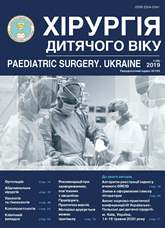Tactical approaches to surgical correction in postoperative complications in the anorectal zone in children
DOI:
https://doi.org/10.15574/PS.2019.65.55Keywords:
anorectoplasty, postoperative complications, anorectal malformations, correctionAbstract
Purpose. To improve the results of surgical correction of postoperative complications in children’s anorectal zone.Materials and methods. 58 patients with IB in the anorectal zone during primary and repeated correction of anorectal malformations (ARM), who underwent 137 reconstructive operations, were examined. The diagnostic algorithm consisted of traditional complex methods of clinical, radiological, laboratory examination, including ultrasound, MRI and endoscopic methods of examination.
Results and concludians. The analysis of long-term results showed that unreliable primary diagnostics, lack of preoperative preparation, inadequate indications for the choice of surgery method led to the development of software for primary and repeated correction of ARM, which required a large number of repeated operations to treat. At the same time, the causes of the complication were studied, errors were analyzed, indications, terms, accesses, volume and efficiency of the primary operation were optimized, as well as failures leading to the necessity of repeated operations in children. Optimization of tactics, methods of surgical and rehabilitation treatment led to improvement of software results up to 85.6%.
The study was carried out in accordance with the principles of the Helsinki Declaration. The study protocol was approved by the Local Ethics Committee of all participating institutions. Informed consent of the parents of the children was obtained for the study.
References
Averin VI i dr. (2015). Anorektalnyie malformatsii u detey (federalnyie klinicheskie rekomendatsii): nauchnoe izdanie. Detskaya hirurgiya.19;4: 29-35.
Geraskin AV, Dronov AF, Smirnov AN. (2012). Detskaya koloproktologiya. Moskva. Izdatelskaya gruppa Kontent. 664.
Lenyushkin AI, Komissarov IA. (2008). Pediatricheskaya koloproktologiya. Moskva.
Navruzov SN i dr. (2014). Oshibki i oslozhneniya pri vyipolnenii operatsii na anorektalnoy zone. Hirurgiya Uzbekistana. 1(61): 65-68.
Salamov KN, Dultsev YuV. (1998). Anorektalnyie anomalii u vzroslyih. Moskva: Meditsina.
Hamraev AZh, Atakulov ZhA. (2015). Bolalar kolorektal hirurgiyasi. Tashkent. Izd. Ukituvchi nashriYot-Matbaa izhodiy uyi: 383.
Shamsiev AM i dr. (2014). Hirurgicheskaya korrektsiya nederzhanie kala pri svischah v polovuyu sistemu u detey. Rossiyskiy vestnik detskoy hirurgii, anesteziologii i reanimatologii.
Creighton SM, Chernausek SD, Romao R, Ransley PG, Pippi Salle J. (2012). Timing and nature of reconstructive surgery for Disorder of Sex Development – Introduction. J Pediatr Urol.8: 602-610.
Gonzalez R, Ludwikiwski B. (2012). Management of the high urogenital sinus – Risk of overexposure? J Urol.187: 787-788.
Pippi Salle L, Lorenzo AJ, Jesus LE et al. (2012). Surgical treatment of high urogenital sinuses using the anterior sagittal transrectal approach: A useful strategy to optimize exposure and outcomes. J Urol.187: 1024-1031.
Shiryaev ND, Kaganov IM. (2012). Essays on reconstructive surgery of the external genitalia in children. Part 2. Syktyvkar: 81.
Downloads
Issue
Section
License
The policy of the Journal “PAEDIATRIC SURGERY. UKRAINE” is compatible with the vast majority of funders' of open access and self-archiving policies. The journal provides immediate open access route being convinced that everyone – not only scientists - can benefit from research results, and publishes articles exclusively under open access distribution, with a Creative Commons Attribution-Noncommercial 4.0 international license(СС BY-NC).
Authors transfer the copyright to the Journal “PAEDIATRIC SURGERY.UKRAINE” when the manuscript is accepted for publication. Authors declare that this manuscript has not been published nor is under simultaneous consideration for publication elsewhere. After publication, the articles become freely available on-line to the public.
Readers have the right to use, distribute, and reproduce articles in any medium, provided the articles and the journal are properly cited.
The use of published materials for commercial purposes is strongly prohibited.

